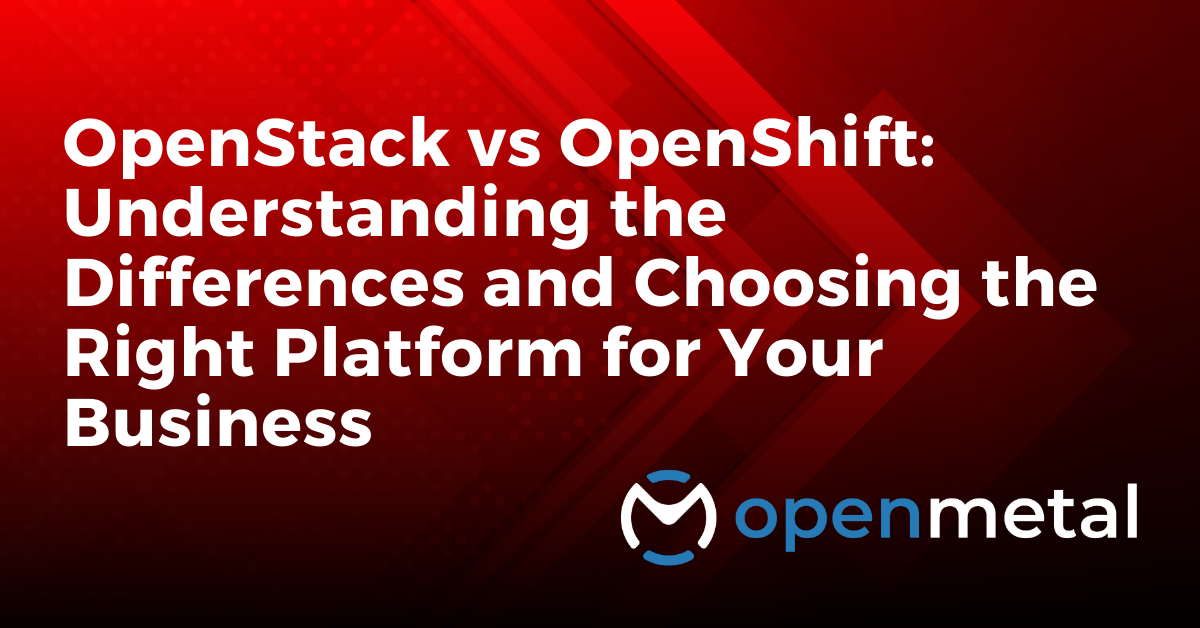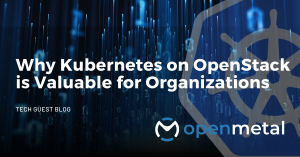
In this blog:
Introduction: Understanding The Differences Between Two Open Source Cloud Computing Platforms
Cloud computing has revolutionized the way we store, manage, and access data. And with profitability top of mind, many organizations are looking for efficient and cost-effective platforms to host their cloud applications. Open source solutions like OpenStack and OpenShift are becoming more popular because platforms offer flexible and scalable cloud computing solutions. However, each is better suited for specific use cases. They have distinct differences in terms of their architecture, deployment, scalability, and application support.
What Is OpenStack?
OpenStack is a cloud platform. It helps build clouds. It provides compute, storage, and networking resources.
OpenStack is based on a modular architecture. OpenStack is made of independent projects. Projects can be used independently or in combination to provide different cloud services. Some of these projects are: Nova (compute), Cinder (storage), and Neutron (networking).
OpenStack can be deployed through various models. With OpenMetal your OpenStack is deployed on a minimum of 3 physical servers.
OpenStack is highly scalable. It can add or remove resources to meet changing demands.
OpenStack provides support for a range of applications. This includes traditional virtual machines and containerized applications.
What Is OpenShift?
OpenShift, is a container application platform. It provides tools for building, deploying, and managing containerized applications.
OpenShift, has a master-worker architecture. The master manages the cluster while the workers run the applications.
OpenShift itself is typically deployed as a set of containers running on a Kubernetes cluster. This containers are managed by OpenShift. OpenShift extends Kubernetes by adding additional features and functionality. This includes integrated application builds, image management, and a web console for managing and monitoring the cluster.
OpenShift is also highly scalable. However, it is primarily designed for scaling containerized applications.
OpenShift, is specifically designed for containerized applications. It provides a range of tools and features for building, deploying, and managing them.
Advantages Of OpenStack
- Cost-effective:
OpenStack is a free, open source platform. This can reduce the cost of building and managing cloud infrastructure. And even if you use a managed OpenStack solution, the savings are still significant when compared to public clouds.
- Flexibility:
OpenStack is flexible and can be deployed in a variety of environments. Including public, private, and hybrid clouds. - Scalability:
OpenStack is designed to be highly scalable. This allows you to easily add or remove compute, storage, and network resources as needed. When you need more resources, you can add them by adding additional nodes to your OpenStack Deployment. This allows you to scale specific services independently. If you need more storage, you can add only storage to your cloud. - Customization:
OpenStack provides a range of APIs and tools that enable organizations to customize the platform. These enable organizations to create a cloud infrastructure that meets their specific business needs. - Large and active community:
OpenStack has a large and active community of developers and users. The community provides support, documentation, and a range of add-ons and extensions to the platform.
- Security:
OpenStack provides a range of security features, including: identity and access management, encryption, and network isolation. This can help organizations ensure the security of their cloud infrastructure and data.
Advantages Of OpenShift
- Ease of deployment:
OpenShift simplifies the deployment of applications. This is accomplished with a container-based environment, preconfigured templates, and an easy-to-use console. This eliminates the need for extensive infrastructure management. And enables quick deployment and scaling of applications.
- Scalability:
OpenShift is scalable. This allows organizations to scale applications up or down as needed. This guarantees that applications can handle increased traffic and demand. It also saves on infrastructure costs.
- Flexibility:
OpenShift can run on a variety of infrastructure.
- Multiple programming languages and frameworks:
OpenShift supports many programming languages and frameworks. This allows developers to work with the tools they are most comfortable with.
- Security:
OpenShift provides a range of security features, including role-based access control, network isolation, and automated security updates. This ensures that applications are secure and compliant with industry regulations.
- Community support:
OpenShift is an open source platform with a large and active community of developers and contributors. Organizations can leverage the expertise of others in the community and contribute to the development of the platform themselves.
Disadvantages Of OpenStack
- Complexity:
OpenStack’s many components can make it difficult for some organizations to set up and manage. This requires investment in training and support. - Resource requirements:
OpenStack requires significant hardware resources. This expensive to deploy and maintain versus choosing a hosted OpenStack Solution.
- Skillset:
OpenStack requires specialized skills and knowledge to manage effectively. This can be a challenge for organizations without the necessary expertise in-house.
Keep in mind that if you are using our OpenStack-Powered Private Cloud we have eliminated most disadvantages of OpenStack.
Disadvantages Of OpenShift
- Complexity:
OpenShift is a complex platform with many components. This can make it difficult for some organizations to set up and manage. Organizations may need to invest in training and support to fully leverage the platform’s capabilities. - Cost:
OpenShift is a commercial product that requires a subscription or license to use. This can make it more expensive than some other open source cloud application platforms. - Vendor lock-in:
While OpenShift is it is a product of Red Hat. This may create vendor lock-in concerns for some organizations. - Limited support for some programming languages and frameworks:
OpenShift supports many popular programming languages and frameworks. However, it may not support all of the tools that some organizations prefer to work with.
Combining OpenStack And OpenShift For A Robust Cloud Computing Solution
While OpenStack and OpenShift have some overlapping functionality, they are not direct competitors. Instead, they complement each other. And can work together to provide a comprehensive solution for cloud computing. OpenStack can provide the infrastructure layer which OpenShift needs to run on. And OpenShift can help manage the deployment and scaling of applications running on OpenStack. These two opens source solutions are designed to work together and solve different problems. When integrated they provide a complete solution for cloud computing needs.
Test OpenShift On OpenStack
Not sure if running OpenShift on OpenStack is the right fit for your organization? Deploy your very own complimentary OpenMetal on-demand OpenStack-powered cloud and follow this guide created by our OpenMetal Engineers. Experience the powerhouse combo of OpenShift on OpenStack for yourself!
Deploy a Cloud OpenShift Guide
More on the OpenMetal Blog…

Why Kubernetes on OpenStack is Valuable for Organizations
In this blog:
- Managing Kubernetes Clusters on OpenStack
- Scalability on OpenStack
- Ways to deploy Kubernetes on OpenStack
- Security on OpenStack

Unleashing the Potential of Cloud-Based Applications with OpenShift
In this blog:
- What is OpenShift
- Key Points To Consider When Deciding To Use OpenShift
- Explore OpenShift Features and Capabilities
- OpenShift on OpenStack

What Are The Advantages of Using OpenStack To Create a Cloud Environment?
In this blog post:
- OpenStack Cost-Effectiveness
- Control over OpenStack
- Open Source Community
- OpenStack Automation
- Kubernetes Integrations
Test Drive
For eligible organizations, individuals, and Open Source Partners, Private Cloud Cores are free to trial. Apply today to qualify.
Subscribe
Join our community! Subscribe to our newsletter to get the latest company news, product releases, updates from partners, and more.


































